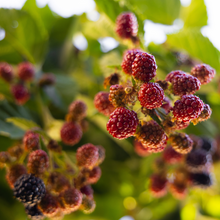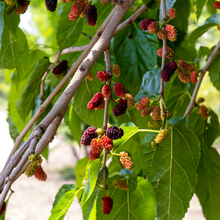- Home
- Exoticflora Favourite's
- Mulberry - Fruits Plant...
Mulberry - Fruits Plant & Tree





Mulberry - Fruits Plant & Tree

 Climate
Climate Time to yield
Time to yield Maximum size
Maximum size


Grafted for faster yield within 12-18 months.

Damaged or lifeless? We’ll replace it for free. Learn more




Double layered custom boxes to protect plants during shipping.

Air vents for proper air-flow

To preserve plant freshness during transit

Details steps of how to grow and maintain your plant
Botanically known as Morus spp., the Mulberry tree is a deciduous plant prized for its sweet, juicy fruits and ornamental value. Native to Asia, Europe, and North America, Mulberries belong to the Moraceae family and are cultivated for their delicious berries, which come in various colors, including black, red, and white. The Mulberry tree typically grows up to 30 feet in height, with a spreading canopy of glossy, serrated leaves that provide ample shade during the hot summer months.
Mulberries are celebrated for their rich, sweet-tart flavor and are enjoyed fresh, dried, or used in jams, jellies, pies, and other culinary creations. Beyond their culinary uses, Mulberries offer a wide array of health benefits, making them a nutritious addition to any diet. The high vitamin C content in Mulberries strengthens the immune system, enhances collagen production, and aids in wound healing.
Growing Tips
- Mulberry trees thrive in well-drained, fertile soil with a pH range between 6.0 to 7.0. They prefer slightly acidic to neutral soil conditions.
- Provide full sunlight exposure for at least 6-8 hours daily to ensure optimal growth and fruit production.
- Mulberry trees are adaptable to various climates but prefer temperate to subtropical regions with moderate rainfall and mild winters.
- Regular watering is essential, especially during dry periods and hot weather. However, avoid overwatering to prevent root rot.
- Pruning should be done during the dormant season to remove dead or diseased branches, shape the tree, and promote new growth.
- Apply organic fertilizer high in nitrogen, phosphorus, and potassium annually in the spring to promote healthy growth and fruit development
Inside the Box
- Mulberry Tree: Approximately 1-2 Feet Height
- Growing Pot (Dark Green color): 8 Inch (Note: The above specifications are indicative; actual dimensions may slightly vary.)
Fruition Time: Below 6 months.
Initial Care for 10-15 Days Just After Receiving Your Plant
- Carefully unpack the plant, ensuring no damage occurs to the leaves or roots.
- Firmly press the soil in the pot and top up with additional soil if necessary to ensure stability.
- Keep the soil consistently moist but not waterlogged. Allow the top inch of soil to dry out between watering sessions.
- Place the plant in a location with ample morning sunlight exposure for 2-3 hours daily during the initial 10-15 days. Avoid immediate transplanting.
- After one month, consider transplanting the plant into a slightly larger pot or directly into the ground, if desired.
- Prune any damaged or dead branches to encourage new growth and maintain plant health.
Selected plant of 8-10 inches
Planted into a 5-inch pot
With healthy, moisture-retaining soil
A care instruction sheet for maintenance guide

Get in touch for best pricing on bulk orders and landscaping projects.
 WhatsApp us
WhatsApp us

Call on 9177805454 (Mon-Sat, 9 AM-6 PM) or WhatsApp us – we’re here to help.
About Exotic Flora
At Exotic Flora, we’re passionate about bridging the gap in bringing plants to everyone. With over 500+ varieties across 7 plant categories, from exotic finds to everyday greens, we bring the entire range to you.
Our plants, sourced from all parts of India are nurtured at Kadiyam, in our 25 acres in-house nursery by a team of expert horticulturists. Once they are ready we ship all our plant varieties across India.
Our services go beyond safe delivery of plants. A dedicated support team is there to help you with any maintenance queries you may have.
At Exotic Flora we always believe in going that extra mile, because everyone should have the plants they love.
Good condition and nice plant health